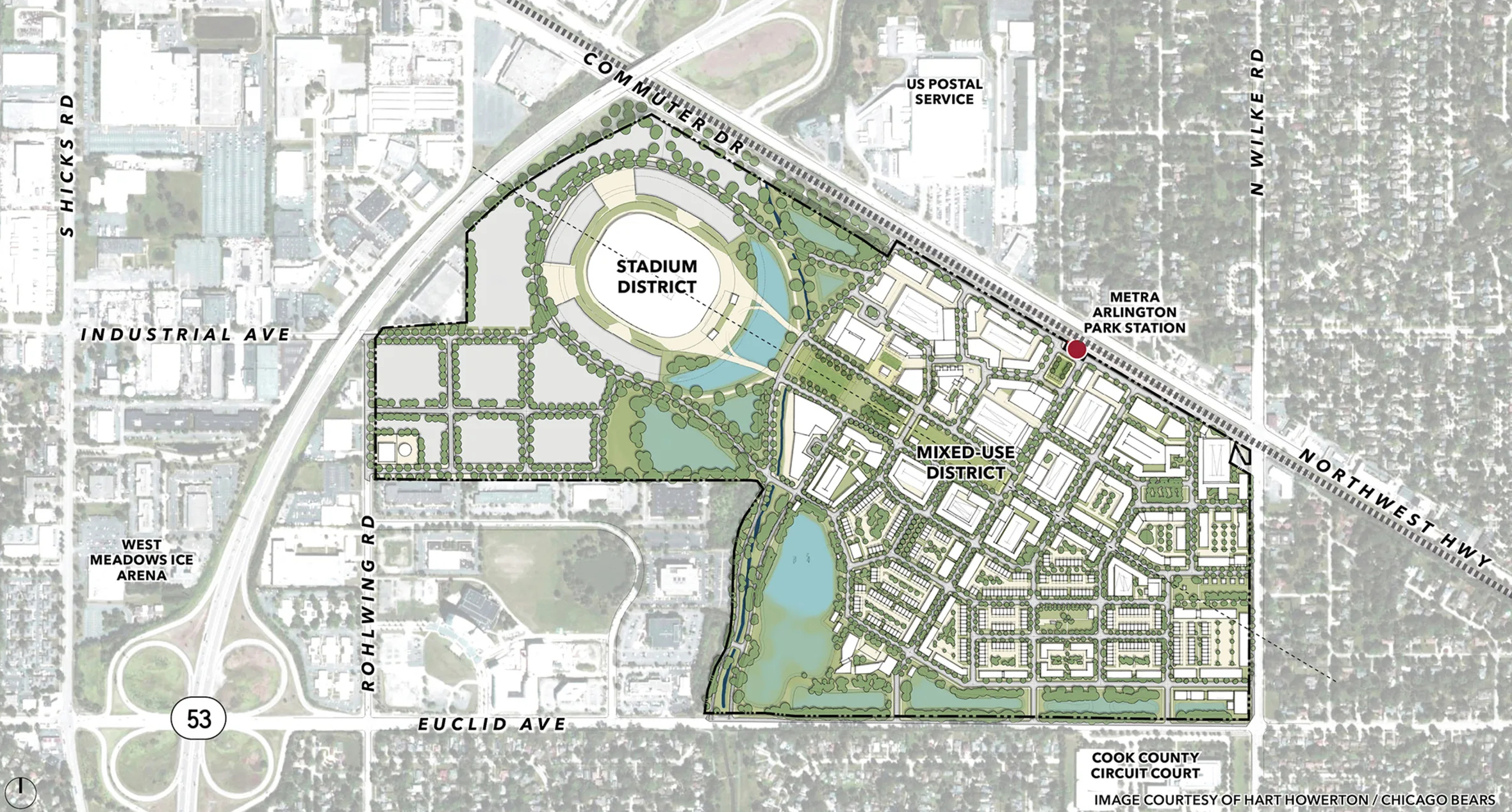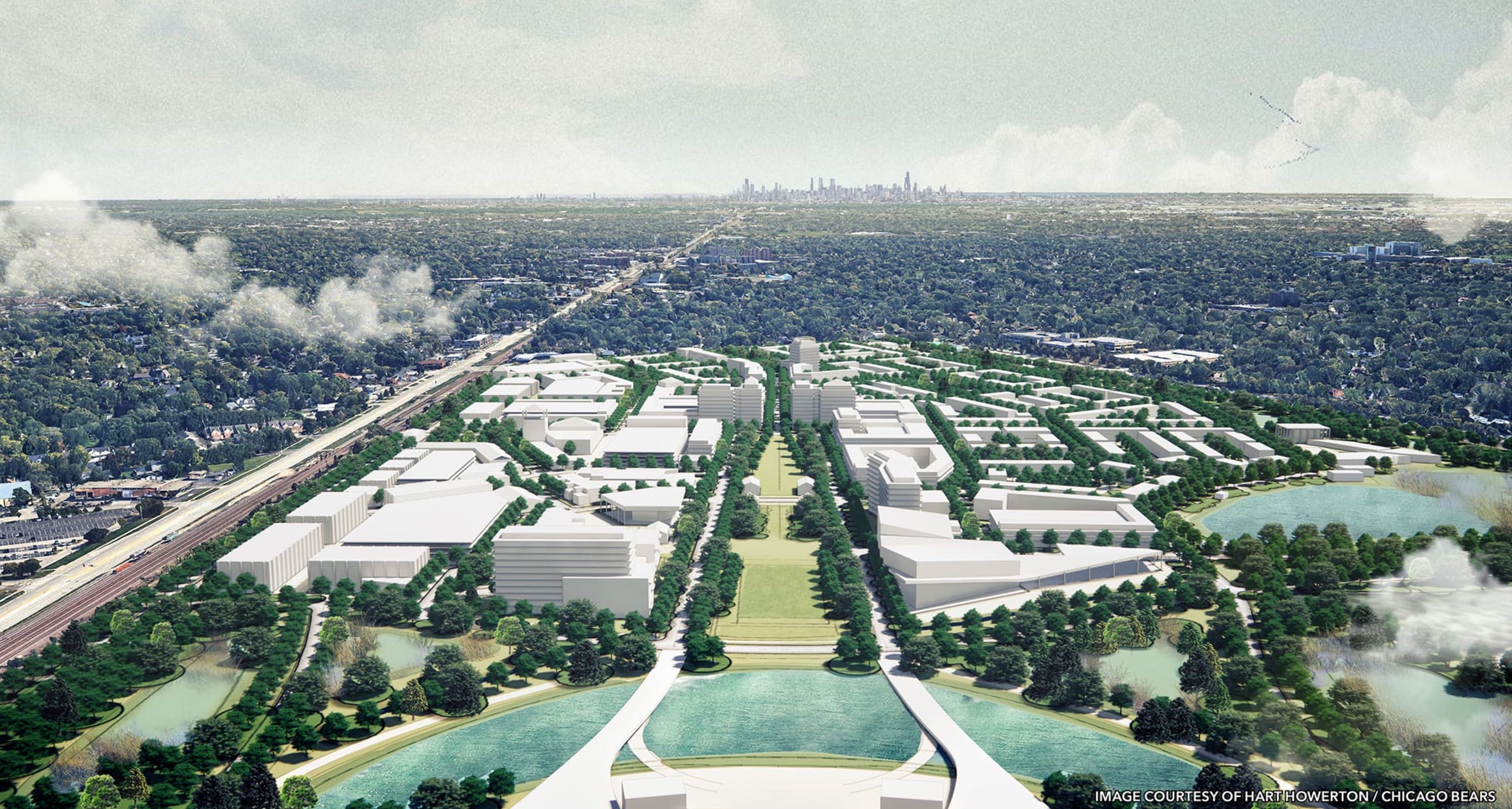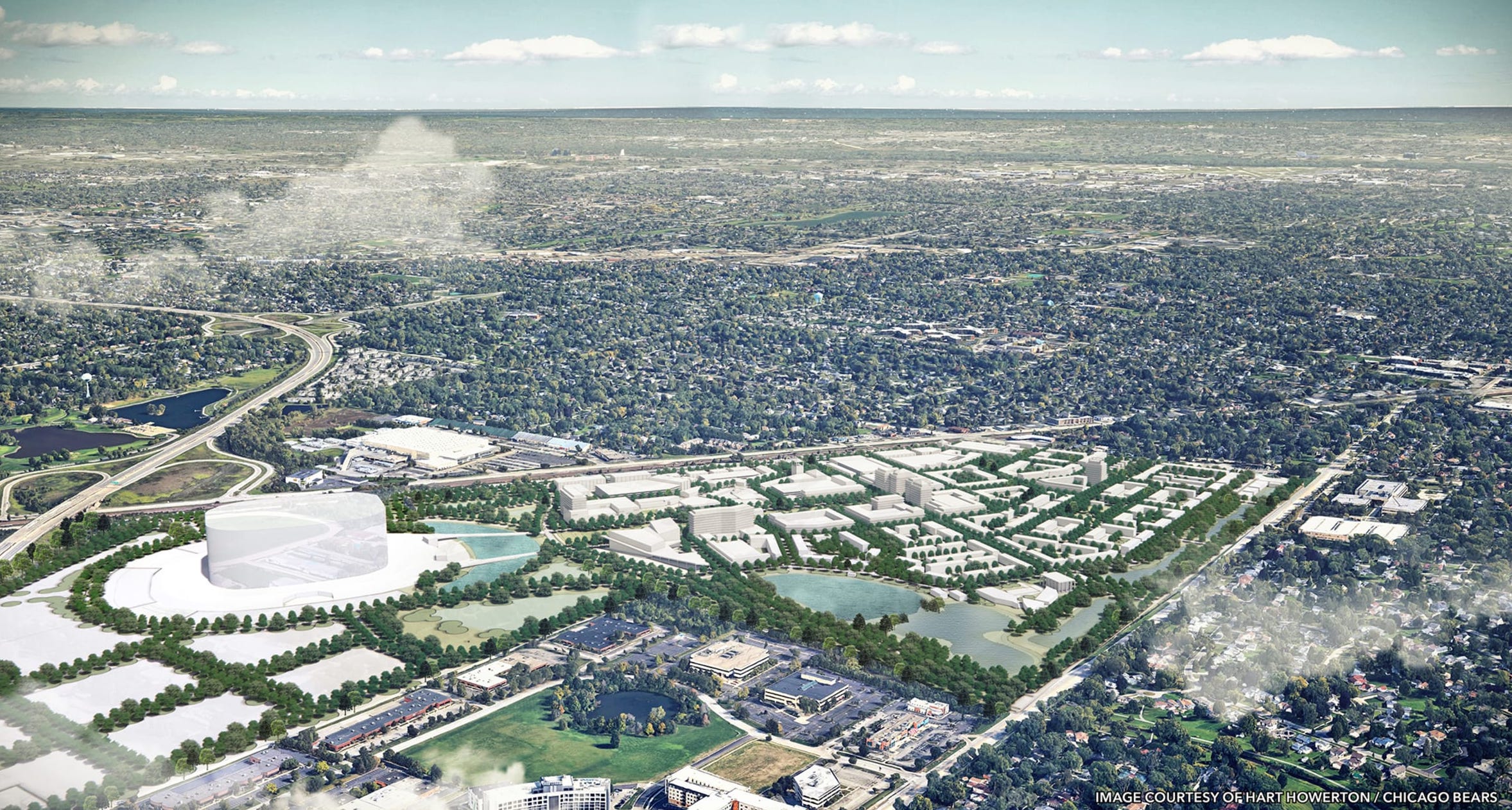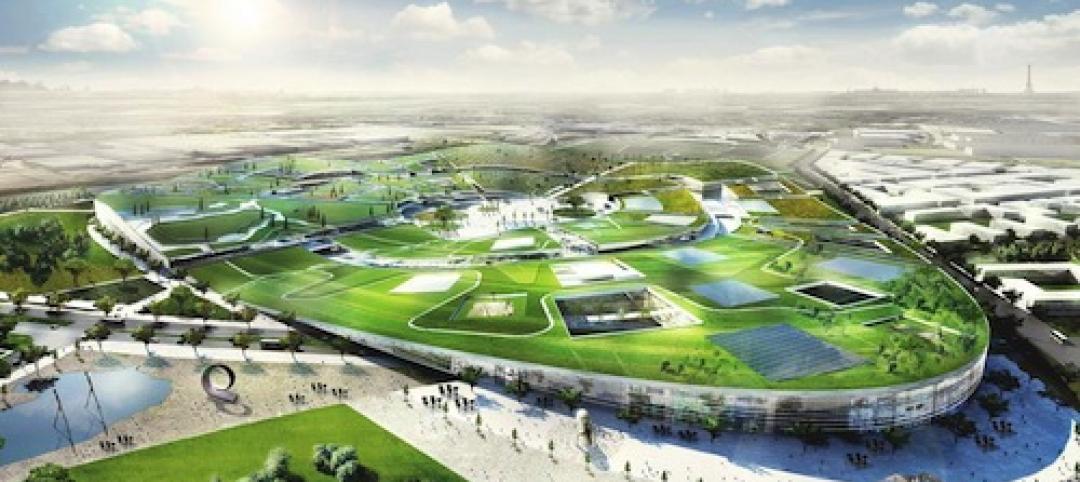As the 2022 NFL season kicks off, one of the league’s original franchises is solidifying plans to leave its landmark lakefront stadium for a multi-billion-dollar mixed-use stadium district in northwest suburban Arlington Heights, Ill.
The Chicago Bears, on Tuesday, released renderings that depict a preliminary master plan for the 326-acre property, the former home of the Arlington International Racecourse. The team, last September, signed a $197.2 million agreement to purchase the land from Churchill Downs Inc. The Bears have yet to close on the property.
The prelim master plan, by architecture firm Hart Howerton, features a 206-acre transit-oriented entertainment and mixed-use district situated on the southeast half of the property, with the 120-acre stadium district on the west side. Water features, tree-lined walking paths, and greenery separate the two districts. Initial plans call for multifamily residential, restaurants, bars, a hotel, and commercial/retail components, with walking access to the stadium and the existing Metra Arlington Park train station.
In an open letter to the public posted on Tuesday, Bears officials unveiled their vision for the project: “a multi-purpose entertainment district anchored by a new, best-in-class enclosed stadium, providing Chicagoland with a new home worthy of hosting global events such as the Super Bowl, College Football Playoffs, and Final Four.” In the same letter, the team noted that the property deal is not yet a sure thing, and that “there are conditions that must be met in order to be in a position to close,” and: “If we do close on the property, it does not guarantee we will develop it.”

In the meantime, the team has cut off discussions with the city of Chicago related to renovating Soldier Field, even as city officials push for a possible deal to keep the Bears in Chicago. In July, the city, in partnership with a development team, released three design concepts for upgrading Soldier Field, including a domed stadium plan that would cost $2 billion.
The Bears, in the open letter, stated that while under contract with Churchill Downs, the team would not explore alternative stadium sites or opportunities. In short, while a deal is not 100% certain, it appears more likely that the Bears will be packing their bags for Arlington Heights within the next decade.
Why would the Chicago Bears leave Chicago?
There are several motivations for leaving Chicago. For one, the Bears do not own Soldier Field; the city does. Under the current Soldier Field contract, which runs through 2033, the franchise must share sizable revenues with the city and must rely on the Chicago Park District for maintenance of the property. Field conditions have been an ongoing issue for the team and NFL league officials, as have event schedule conflicts, parking capacity, accessibility, the overall fan experience.
Secondly, with a capacity of just 61,500, Soldier Field is the smallest stadium in the NFL, with nearly 20,000 fewer seats than Dallas Cowboys’ AT&T Stadium and 21,000 fewer seats than MetLife Stadium, home of the New York Giants and Jets.
ALSO SEE: Chicago proposes three options for Soldier Field renovation including domed stadium
The biggest motivation, perhaps, is the unrealized revenue potential for one of the world’s most valuable sports franchises ($5.8 billion, No. 6 on Forbes’ World’s 50 Most Valuable Sports Teams 2022). The Bears have watched other sports organizations—Atlanta Braves, Chicago Cubs, Green Bay Packers, Milwaukee Bucks, to name a few—cash in on private and public-private sports-anchored entertainment districts that draw year-round crowds and create a more diverse revenue model.

Who’s going to pay for the Chicago Bears stadium?
According to the Bears, its Arlington Heights plan would not call for public funding for direct stadium structure construction. The organization left open the possibility of seeking public funds to assist with the development of the other portions of the development.
The team believes that any public investment is money well spent given the short-term and ongoing benefit to the Chicagoland community, Cook County, and the state of Illinois. The Bears stated: “Construction of the proposed project is projected to create more than 48,000 jobs, result in $9.4 billion in economic impact for Chicagoland, and provide $3.9 billion in labor income to workers across the region, while the completed project will create more than 9,750 long-term jobs, result in $1.4 billion in annual economic impact for Chicagoland and provide $601 million in annual labor income to workers across Chicagoland. We also anticipate that the development will generate $16 million in annual tax revenue in addition to property taxes for Arlington Heights, $9.8 million for Cook County, and $51.3 million for the State of Illinois.”
Related Stories
| May 16, 2013
Chicago unveils $1.1 billion plan for DePaul arena, Navy Pier upgrades
Hoping to send a loud message that Chicago is serious about luring tourism and entertainment spending, Mayor Rahm Emanuel has released details of two initiatives that have been developing for more than a year and that it says will mean $1.1 billion in investment in the McCormick Place and Navy Pier areas.
| May 7, 2013
First look: Golden State Warriors stadium by Snøhetta, AECOM
Architects Snøhetta and AECOM have revealed their latest renderings of a new stadium for NBA basketball team the Golden State Warriors on the waterfront in San Francisco.
| May 2, 2013
Holl-designed Campbell Sports Center completed at Columbia
Steven Holl Architects celebrates the completion of the Campbell Sports Center, Columbia University’s new training and teaching facility.
| Apr 30, 2013
Tips for designing with fire rated glass - AIA/CES course
Kate Steel of Steel Consulting Services offers tips and advice for choosing the correct code-compliant glazing product for every fire-rated application. This BD+C University class is worth 1.0 AIA LU/HSW.
| Apr 26, 2013
BIG tapped to design Europa City in suburban Paris
Danish architecture firm, BIG - led by Bjarke Ingels – has been announced as the winner of an international invited competition for the design of Europa City, a 800,000 square meter cultural, recreational and retail development in Triangle de Gonesse, France.
| Apr 24, 2013
Los Angeles may add cool roofs to its building code
Los Angeles Mayor Antonio Villaraigosa wants cool roofs added to the city’s building code. He is also asking the Department of Water and Power (LADWP) to create incentives that make it financially attractive for homeowners to install cool roofs.
| Apr 12, 2013
Chicago rail conversion puts local twist on High Line strategy
Plans are moving forward to convert an unused, century-old Chicago rail artery to a 2.7 mile, 13 acre recreational facility and transit corridor.
Building Enclosure Systems | Mar 13, 2013
5 novel architectural applications for metal mesh screen systems
From folding façades to colorful LED displays, these fantastical projects show off the architectural possibilities of wire mesh and perforated metal panel technology.
| Mar 5, 2013
Recycled recreation: Waste-to-energy plant combines with ski resort
A new project near Copenhagen pushes the boundaries of the term "mixed use," combining a waste-to-energy plant with a ski resort.
















